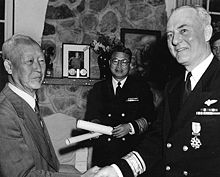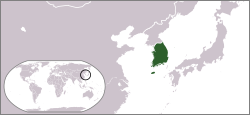First Republic of Korea
| Republic of Korea | ||||||||||||
| 대한민국 大韓民國 |
||||||||||||
|
||||||||||||
|
||||||||||||
|
Anthem 애국가 "Aegukga" |
||||||||||||
| Capital | Seoul, Pusan (temporary capital from 1950 to 1952 due to war) | |||||||||||
| Languages | Korean | |||||||||||
| Government | Federated presidential republic | |||||||||||
| President | Syngman Rhee | |||||||||||
| Vice President | ||||||||||||
| • | 1948–1951 | Yi Si-yeong | ||||||||||
| • | 1951–1952 | Kim Seong-su | ||||||||||
| • | 1952–1956 | Ham Tae-young | ||||||||||
| • | 1956–1960 | Jang Myeon | ||||||||||
| Legislature | National Assembly | |||||||||||
| Historical era | Cold War | |||||||||||
| • | Proclamation of the Republic of Korea | 15 August 1948 | ||||||||||
| • | Korean War | 25 July 1950 - 27 July 1953 | ||||||||||
| • | April Revolution | 19 April 1960 | ||||||||||
| Currency |
Won (1945–1953) Hwan (1953–1962) |
|||||||||||
|
||||||||||||
| First Republic of South Korea | |

South Korean President Syngman Rhee bestowing a medal on a U.S. Navy admiral.
|
|
| Korean name | |
|---|---|
| Hangul | 제1공화국 |
| Hanja | 第一共和國 |
| Revised Romanization | Jeil Gonghwaguk |
| McCune–Reischauer | Cheil Konghwaguk |
The First Republic of South Korea (Korean: 제1공화국, Jeil Gonghwaguk, literally "the first republic") was South Korea's first independent government, ruling the country from 1948 to 1960. It succeeded USAMGIK, the United States military government, which ruled the area from 1945 to 1948. The Philippines recognized South Korea on 15 August 1948. The First Republic was established on August 15, 1948, with Syngman Rhee as the first president. Like subsequent governments, it claimed sovereignty over the entire Korean Peninsula, although it only had power over the area south of the 38th parallel. The investiture of the Rhee government followed the general election of May 10, 1948. The country's first constitution had been promulgated by the first National Assembly on July 17. It established a system with a strong president, who was elected indirectly by the National Assembly.
Rhee was supported in the elections by the Korea Democratic Party, but didn't include any of its members in his cabinet. In retaliation, the members of the party formed a united opposition Democratic Nationalist Party, and began to advocate a cabinet system which would remove power from the president. This led to a regrouping of the Rhee faction into the Nationalist Party, which later became the Liberal Party, and remained Rhee's base throughout his administration. The country's second parliamentary elections were held on May 30, 1950, and gave the majority of seats to independents.
The South Korean government continued many of the practices of the U.S. military government. This included the brutal repression of leftist activity. The Rhee government continued the harsh military action against the Jeju Uprising. It also crushed military uprisings in Suncheon and Yeosu, which were provoked by orders to sail to Jeju and participate in the crackdown.
...
Wikipedia



